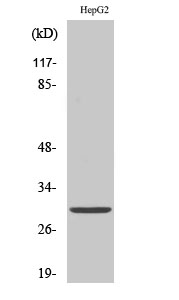14-3-3 ε Polyclonal Antibody
- Catalog No.:YT0005
- Applications:WB;IHC;IF;ELISA
- Reactivity:Human;Mouse;Rat
- Target:
- 14-3-3 ε
- Fields:
- >>Cell cycle;>>Oocyte meiosis;>>PI3K-Akt signaling pathway;>>Hippo signaling pathway;>>NOD-like receptor signaling pathway;>>Neurotrophin signaling pathway;>>Hepatitis C;>>Viral carcinogenesis
- Gene Name:
- YWHAE
- Protein Name:
- 14-3-3 protein epsilon
- Human Gene Id:
- 7531
- Human Swiss Prot No:
- P62258
- Mouse Gene Id:
- 22627
- Mouse Swiss Prot No:
- P62259
- Rat Gene Id:
- 29753
- Rat Swiss Prot No:
- P62260
- Immunogen:
- The antiserum was produced against synthesized peptide derived from human 14-3-3 epsilon. AA range:206-255
- Specificity:
- 14-3-3 ε Polyclonal Antibody detects endogenous levels of 14-3-3 ε protein.
- Formulation:
- Liquid in PBS containing 50% glycerol, 0.5% BSA and 0.02% sodium azide.
- Source:
- Polyclonal, Rabbit,IgG
- Dilution:
- WB 1:500 - 1:2000. IHC 1:100 - 1:300. IF 1:200 - 1:1000. ELISA: 1:20000. Not yet tested in other applications.
- Purification:
- The antibody was affinity-purified from rabbit antiserum by affinity-chromatography using epitope-specific immunogen.
- Concentration:
- 1 mg/ml
- Storage Stability:
- -15°C to -25°C/1 year(Do not lower than -25°C)
- Other Name:
- YWHAE;14-3-3 protein epsilon;14-3-3E
- Observed Band(KD):
- 29kD
- Background:
- This gene product belongs to the 14-3-3 family of proteins which mediate signal transduction by binding to phosphoserine-containing proteins. This highly conserved protein family is found in both plants and mammals, and this protein is 100% identical to the mouse ortholog. It interacts with CDC25 phosphatases, RAF1 and IRS1 proteins, suggesting its role in diverse biochemical activities related to signal transduction, such as cell division and regulation of insulin sensitivity. It has also been implicated in the pathogenesis of small cell lung cancer. Two transcript variants, one protein-coding and the other non-protein-coding, have been found for this gene. [provided by RefSeq, Aug 2008],
- Function:
- function:Adapter protein implicated in the regulation of a large spectrum of both general and specialized signaling pathway. Binds to a large number of partners, usually by recognition of a phosphoserine or phosphothreonine motif. Binding generally results in the modulation of the activity of the binding partner.,similarity:Belongs to the 14-3-3 family.,subcellular location:Identified by mass spectrometry in melanosome fractions from stage I to stage IV.,subunit:Homodimer. Heterodimerizes with YWHAZ. Interacts with NDEL1, RGNEF and TIAM2 (By similarity). Interacts with HCV core protein. Interacts with ABL1 (phosphorylated form); the interaction retains it in the cytoplasm. Weakly interacts with CDKN1B.,
- Subcellular Location:
- Nucleus . Cytoplasm . Melanosome . Identified by mass spectrometry in melanosome fractions from stage I to stage IV. .
- Expression:
- B-cell lymphoma,Brain,Cajal
Protein C‐terminal enzymatic labeling identifies novel caspase cleavages during the apoptosis of multiple myeloma cells induced by kinase inhibition. PROTEOMICS Proteomics. 2016 Jan;16(1):60-69 WB Human OPM2 cell
- June 19-2018
- WESTERN IMMUNOBLOTTING PROTOCOL
- June 19-2018
- IMMUNOHISTOCHEMISTRY-PARAFFIN PROTOCOL
- June 19-2018
- IMMUNOFLUORESCENCE PROTOCOL
- September 08-2020
- FLOW-CYTOMEYRT-PROTOCOL
- May 20-2022
- Cell-Based ELISA│解您多样本WB检测之困扰
- July 13-2018
- CELL-BASED-ELISA-PROTOCOL-FOR-ACETYL-PROTEIN
- July 13-2018
- CELL-BASED-ELISA-PROTOCOL-FOR-PHOSPHO-PROTEIN
- July 13-2018
- Antibody-FAQs
- Products Images

- Western Blot analysis of various cells using 14-3-3 ε Polyclonal Antibody diluted at 1:1000

- Western blot analysis of lysates from HepG2 and Jurkat cells, using 14-3-3 epsilon Antibody. The lane on the right is blocked with the synthesized peptide.

- Immunohistochemical analysis of paraffin-embedded human small intestinal carcinoma tissue. 1,primary Antibody was diluted at 1:200(4° overnight). 2, Sodium citrate pH 6.0 was used for antigen retrieval(>98°C,20min). 3,Secondary antibody was diluted at 1:200



